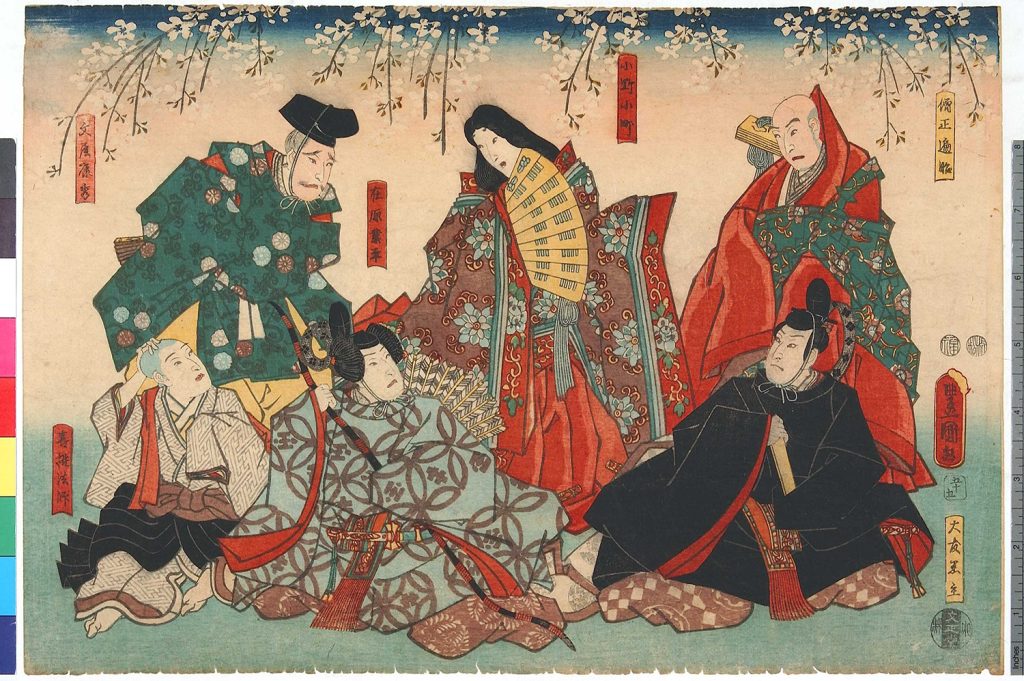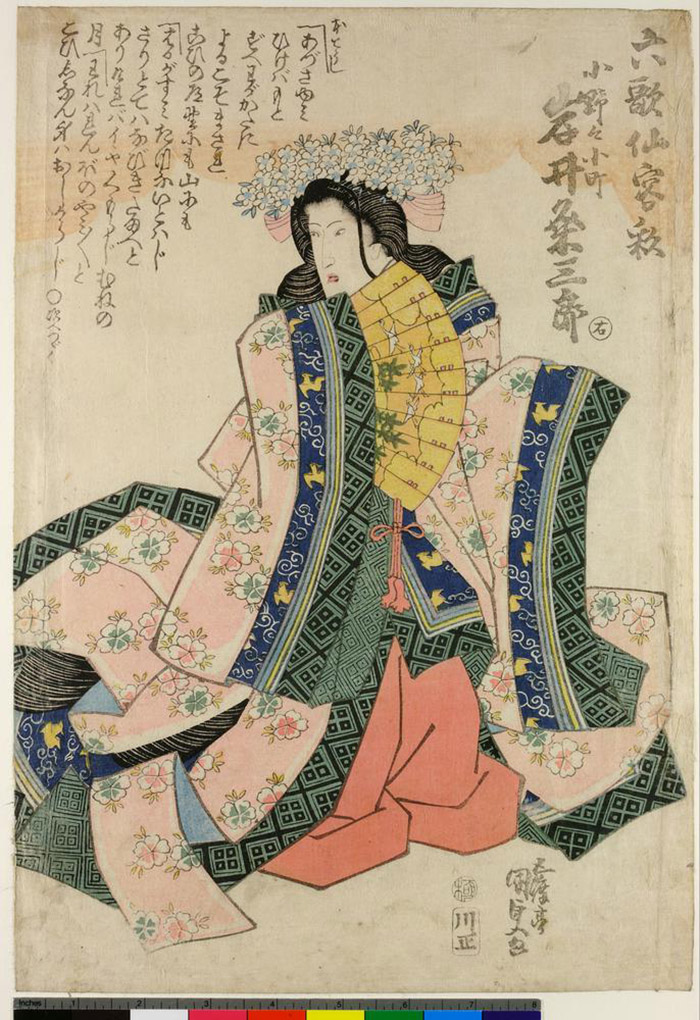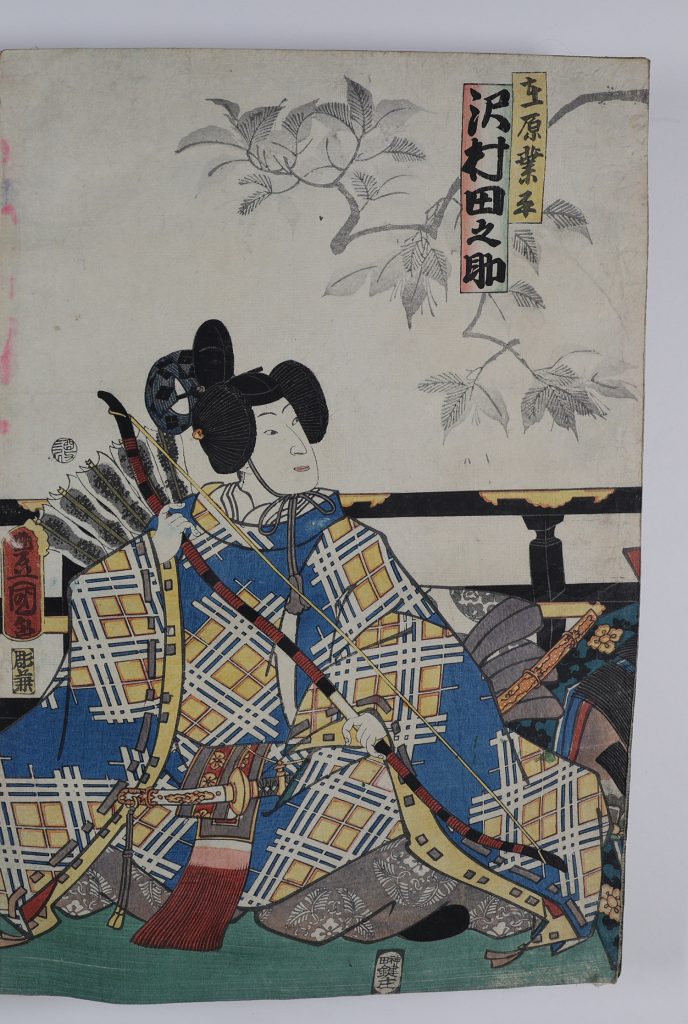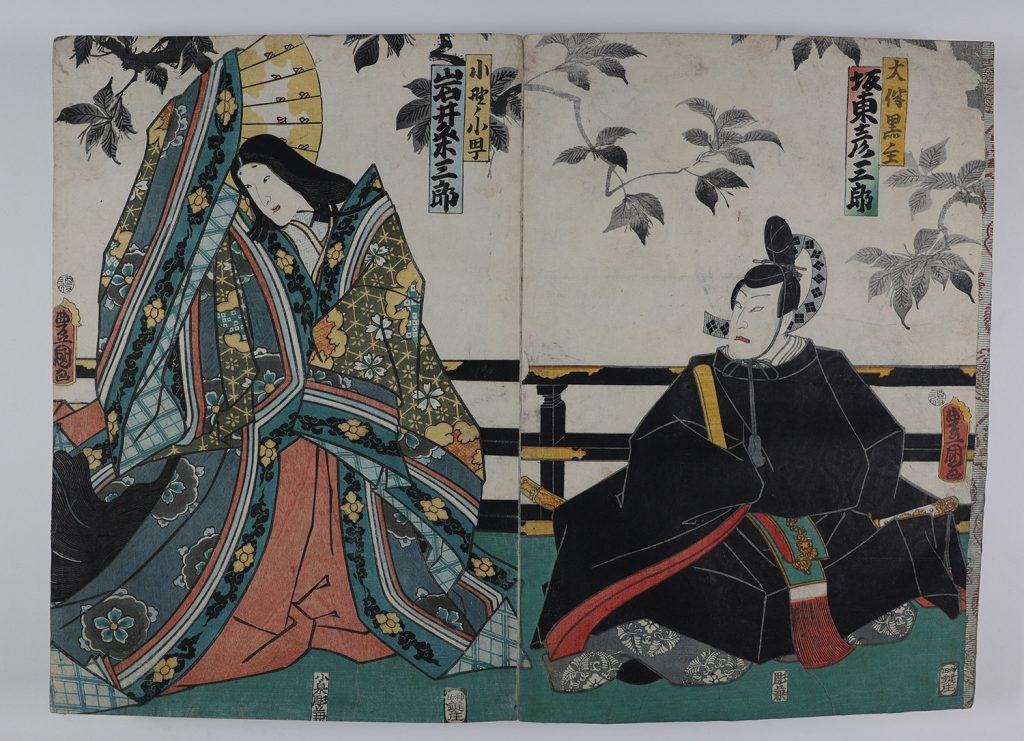Plates 16-18: Triptych of actors Ichikawa Kuzo II, Sawamura Tanosuke III, and Nakamura Shikan IV
Plates 16-18: Triptych of actors Ichikawa Kuzo II, Sawamura Tanosuke III, and Nakamura Shikan IV
Utagawa Yoshitora (歌川 芳虎) (act. ca. 1836-1887)
Meeting of loyal retainers in Oribe house (Gishi oribe taku shūkai zu 義士織部宅集会図)
Ink and color on paper
Seals:
Publisher: Kanda Kagisho 神田鍵庄, possibly referring to publisher Kagiya Shobei located in Kanda, Edo
Censor: 1860 III
Carver: Koizumi Horikane 小泉彫兼
Artist: Toyokuni ga (in a toshidama waku)
Inscriptions of actor and character names (right to left): Bandō Hikusaburō 坂東彦三郎 [as] Otomo no Kuronushi, Iwai Kumesaburō 岩井粂三郎 [as] Ono no Komachi, and Sawamura Tanōsuke 澤村 田之助 [as] Ariwara no Narihira
Among the later prints of Utagawa Kunisada’s prolific career, this triptych shows kabuki actors as three waka poets of the Rokkasen (“six poet immortals”) from the Heian period (794 – 1185). They were originally grouped together in the canonical anthology of waka poetry, Kokin Wakashū 古今和歌集 (Collection of Japanese Poems of Ancient and Modern Times, 9th century), and considered the representative figures of classical poetry.1 In the mid-19th century, there was an increased presence of classical court literature and poet-authors in popular culture due to the dissolution of hereditary social hierarchy. As a result of burgeoning literacy rates and the possibility of social mobility through cultivating “taste,” consumers of art and literature studied, discussed, and transformed the classical canon.2 In addition to the popularity of kabuki plays about classical subjects, ukiyo-e also made classical literature more accessible to the public; illustrative prints for the medieval waka anthology Hyakunin isshu 百人一首 (One Poem Each of One Hundred Poets, 12th-13th century), which also included the works of Rokkasen, made the anthology extremely popular.3
Rokkasen would have been known to kabuki-goers through the play Rokkasen sugata no irodori 六歌仙容彩 (Colorful Guises of the Six Poet Immortals), first performed in 1831 at the Nakamura-za in Edo (modern-day Tokyo).4 Although the subject matter appears literary, the play is actually about the five male poets of the six attempting to seduce the one female poet, Ono no Komachi 小野小町 (825 – 900).5 Although I could not match the present print with a known performance of the play with the same actors, the print adheres to the typical imagery of Rokkasen sugata no irodori. The appearance, costume, and pose of the three poets are almost identical to an 1851 Kunisada print of a contemporaneous performance featuring all six actors as poets together (figure 1).6 The actors in both prints don costumes true to the Heian period though with different designs; in fact, Ono no Komachi’s jūnihitoe 十二単 (“twelve layers”) court dress and hiogi 檜扇 (“cypress fan”) are consistent with a Kunisada print of the play from 1831 (figure 2).7 Because of the frequent appearance of the Rokkasen as a group of six, it is possible that the present triptych is a part of a series with six poets on individual sheets of paper that could have been sold separately or combined.


The absence of a performance contemporaneous to the print has various potential explanations: for example, to subvert growing censorship over actor prints, a growing trend among ukiyo-e artists dissociated actor prints from contemporary performances and issued retrospective series of actor prints, which uncoupled the production of ukiyo-e from specific kabuki performances.8 Another possible reason was the reusing of Kunisada’s earlier prints by craftsmen in his workshop, who maintained a precise stylistic consistency with Kunisada, which would also explain the parallels in the depiction of the present Rokkasen with his earlier prints of the same subject.9 Whatever the reason, this print reveals the functioning of ukiyo-e at the intersection of theater, literature, and artistic productions in popular culture.
Sophia Liu
History of Art, English, and Classical & Mediterranean Studies
Class of 2023
Annotated Bibliography
Brandon, James R., and Samuel L. Leiter, eds. Kabuki Plays on Stage: Darkness and Desire, 1804-1864. Vol. 3. 4 vols. Honolulu: University of Hawai’i Press, 2002.
This book consists of the English translations of representative kabuki plays from 1804 to 1864 with individual introductions to each of them as well as a general introduction that contextualizes the theater scene in relation to the political and social background. The book includes an English translation of the 1831 Rokkasen Sugata no Irodori 六歌仙容彩 (Colorful Guises of the Six Immortal Poets), which is one of the kabuki representations of the Rokkasen. This book’s introduction to the play discusses the plot of the play and the historical origin of the six immortal poets.
Tinios, Ellis. “Kunisada and the Last Flowering of ‘Ukiyo-e’ Prints.” Print Quarterly 8, no. 4 (1991): 342–62. http://www.jstor.org/stable/41824668.
The article provides a concise summary of the works of Kunisada with special attention given to his later works (1844 and on), the social and cultural context, and the process and commercial value of Kunisada’s prints. Its discussions about the decoupling of actor prints from specific performances since the 1840s in order to avoid censorship and the reprinting of older prints in Kunisada’s workshop address why the subject matter of the present print cannot be matched with a contemporaneous play.
Tinios, Ellis. Mirror of the Stage: The Actor Prints of Kunisada. The University Gallery Leeds, 1996.
Considering the works of Kunisada as revealing the complex relationship between art, culture, and consumer society, this book provides ample information on both Kunisada’s works and their cultural and consumeristic value. The in-depth discussion about the different circumstances of producing kabuki actor prints and their varying usage reveals in particular the complicated and multi-factored process through which kabuki actor prints come into being. This discussion offers different ways to conjecture the context of the present print.
Schaap, Robert. Kunisada: Imaging Drama and Beauty. Hotei Publishing, 2016.
A more recent publication on the subject of Kunisada, this book is a helpful compilation of previous scholarly works on Kunisada since the early 1990s. Consisting of more than 1000 catalogued prints by Kunisada divided into categories of actor prints, women prints, landscape, etc., the book is particularly helpful for situating the present print in relation to prints of the same era and subject matter.
Witkam, Frank. “Classical Court Poetry as Didactic Entertainment: Utagawa Kuniyoshi’s Hyakunin Isshu No Uchi.” Andon 103, no. Spring (2017): 5–21.
This article is about Utagawa Kuniyoshi’s contemporaneous ukiyo-e series based on the medieval poetry anthology Hyakunin isshu and discusses the role of medieval poets and poetry in popular culture at that time. The article’s discussion about how the depiction of waka poets in ukiyo-e receive influences from popular theatre is particularly helpful; one of the poets discussed is Ono no Komachi, who is also among the poets in the present print.


